How U.S. public health cuts could raise risks of infectious diseases
At 6 a.m. on March 25, Philip Huang, director of the Dallas County Health and Human Services department, got a devastating email. Millions of dollars in federal grants that the health agency had were suddenly gone.
The U.S. Department of Health and Human Services had just rescinded about $12 billion from thousands of state and local health agencies, including Huang’s.
Some of that money was part of a COVID-19 recovery program that health departments were using to beef up testing for many diseases, including bird flu and measles as well as COVID-19. In Dallas, it was going toward a public health lab to expand such testing. Also on the chopping block: a grant that paid for staff providing childhood vaccines, including the measles vaccine, Huang said March 28 in a news briefing to discuss ongoing Trump administration cuts to public health.
Just days later on April 1, thousands of HHS employees learned their jobs were being eliminated. It was part of an unprecedented reduction in force, including workers at the U.S. Centers for Disease Control and Prevention, the Food and Drug Administration and the National Institutes of Health involved in all aspects of infectious diseases research, prevention and treatment. While those cuts are starting to be challenged, much uncertainty remains.
In addition to domestic cuts, funding for pandemic preparedness, vaccines and malaria will be targeted, documents the U.S. State Department sent to Congress suggest. This follows the United States’ withdrawal from the World Health Organization and the dismantling of the U.S. Agency for International Development, which helped distribute lifesaving medications and vaccines around the world.
HHS Secretary Robert F. Kennedy Jr. has pledged to “make America healthy again.” And Trump administration officials say the moves are needed to make government more efficient. But it’s unclear how the breadth of cuts to programs, public health employees and infrastructure will achieve those goals.
To the contrary, public health experts warn that the cuts — ranging from local outreach to global surveillance — will undermine efforts to keep infectious diseases in check, making Americans more vulnerable.
“We’re not just building up infrastructure, doing work that’ll just help the next pandemic, it’s to help all disease.”
Nevan Krogan
director of the Quantitative Biosciences Institute
“Fear and silence and sudden closures are causing great inefficiency in public health,” says Matifadza Hlatshwayo Davis, health director for the city of St. Louis. “If the goal is efficiency, there is nothing efficient about this,” she says. “This is not a way that I want my taxpayer dollars handled with this level of chaos.”
Here is a closer look at some of the ways these different layers of government public health each play a role in helping to protect individuals and communities from disease — and how cuts could impact those roles.
Stopping diseases from reaching American borders
“We know that infectious diseases do not respect borders,” says Janeen Madan Keller, deputy director of global health policy at the Center for Global Development, a nonpartisan think tank based in Washington, D.C., and London. “So it’s really, really important that we have the ability to stop these outbreaks in their tracks, including in places in faraway corners of the world before they reach our borders.”
The United States spends about $1.5 billion each year on global health security to help prepare for and prevent pandemics, epidemics and disease outbreaks around the world, Madan Keller says. “This amount really is quite modest when we compare it to the outsized benefits it has on the lives of people who live here in the United States, as well as on the lives of people around the world.”
For instance, there is an estimated $26 return on investment for every dollar spent on vaccines when weighed against the cost of illnesses prevented, according to a 2020 study in Health Affairs. The return is even greater — $54 for every dollar spent — when weighing the value of lives saved by vaccines, researchers calculated.
“Any efforts that undermine work to detect and contain these outbreaks … could not only roll back many, many years of progress … but also really put the lives of people here at the United States at risk,” Madan Keller says.
One program on the chopping block is the global vaccine alliance GAVI. That program, which distributes vaccines to lower-income countries, vaccinated more than 1.1 billion children worldwide and saved nearly 19 million lives from 2000 to 2023, according to the organization’s 2023 progress report.

For instance, GAVI helped to stop the Ebola epidemic in West Africa a decade ago, and established a stockpile of Ebola vaccines that can be deployed when there is an outbreak, such as one in Uganda this year, says Anita Shet, a pediatrician and infectious diseases researcher at Johns Hopkins Bloomberg School of Public Health.
Ebola outbreaks have popped up multiple times since, “but not a single case came into the U.S.,” Shet says. “That’s a classic example of how American health is protected when we when we have this GAVI work going on outside the country.”
A global network of 700 laboratories monitoring measles and rubella that was funded solely by the United States also faces “imminent shutdown,” WHO Director-General Tedros Adhanom Ghebreyesus said during a news briefing March 17 in Geneva. “This comes at the worst possible time when measles is making a comeback.”
That includes in the United States, as well as in Canada and across Europe. Measles was officially eliminated from United States in 2000, but travelers can import the virus, sparking outbreaks among pockets of unvaccinated people. This year, a large outbreak in West Texas has sickened more than 400 people, killed one child and spread to other states and into Mexico. In total, outbreaks and isolated measles cases have been reported in 19 states and in New York City so far this year.
From basic research to disease response
On April 1, HHS employees showed up for work only for many to find out they’d been fired. It’s part of an administration plan to restructure the agency and reduce its workforce by 20,000. While some of those moves may be reversed, and many are likely to be challenged — the American Public Health Association is among those who have filed lawsuits arguing the cuts are “a reckless and illegal purge” — for now, it’s left large swathes of the national public health system in chaos.
For now, the moves have eliminated whole agencies and offices, such as the entire staff of the Office of Infectious Disease and HIV/AIDS Policy. Thanks in part to this office’s leadership, HIV is now a chronic disease for many people rather than a death sentence.
“We have the tools we need to end the HIV epidemic in the United States,” Anna Person, an HIV infectious diseases physician at Vanderbilt University Medical Center in Nashville, said April 1 in a news briefing sponsored by the Infectious Diseases Society of America. “President Trump recognized this during his first term and launched the first ever initiative to end the HIV epidemic in America.” Now, she said, “we are on a fast track to undoing decades of progress, and each new day seems to endanger our gains against this epidemic.”
HIV-fighting infrastructure was built over four decades, Person said. Its rapid disassembly could mean it will take another 40 years to rebuild.

Many NIH research grants and programs are also slated for termination, singled out by the advisory entity called the Department for Government Efficiency, or DOGE. Those include a vast array of studies on sexually transmitted diseases, COVID-19 and vaccines. The mass cancellations include studies investigating how parainfluenza virus infects cells, development of vaccines and medications that can protect against many different coronaviruses and understanding how rhinovirus-caused colds affect children who have had bone marrow transplants.
Among the programs axed was a network of antiviral drug discovery centers, known as AViDD. When the COVID-19 pandemic hit, there were no drugs to treat coronavirus infections, says Nevan Krogan, a systems biologist and director of the Quantitative Biosciences Institute at the University of California, San Francisco. The centers were established to develop antivirals against coronaviruses and six other virus families with potential to spark a pandemic.
Krogan’s team of scientists in 43 laboratories around the world have already identified two potential drugs to target SARS-CoV-2 and two other coronaviruses. One is close to going into clinical trials. And the researchers were gearing up to test the two candidate drugs in combination in mice.
Those projects and work at eight other AViDD centers ended midway through the approved funding cycle. “They just came and said, ‘You have to stop everything right now. The grant is terminated, so you know, there’s no more funds to continue the work.’” Krogan says he felt “devastating shock, disappointed, anxious, like, ‘What are we going to do?’”
He and colleagues will look for other ways to push the work forward, he says, but pharmaceutical companies may not be ready to invest in the still early-stage work. “If we had another year or two, I think we would have gotten to a place where they would have been more digestible for the pharma companies to engage.”
Closing the pandemic preparedness centers won’t just hamper efforts to fight off viruses, Krogan says. “We’re not just building up infrastructure, doing work that’ll just help the next pandemic, it’s to help all disease,” he says. “Studying one disease helps understanding another disease. It’s all connected.”
Boots on the ground
When Huang in Dallas got the email about rescinded federal funds, it was “really abrupt notification with no ability to try to scale down or do anything,” he said. Among other things, it left him and his health department scrambling to figure out how to save the jobs of epidemiologists tasked with disease investigations and contact tracing, especially important in a state with a large measles outbreak.

In St. Louis, Hlatshwayo Davis worries about a basic nutrition support and education program for young people her health department conducted in partnership with the YMCA. The program’s funds were part of about $4 million lost when the Trump administration rescinded the COVID grants. Abruptly shuttering such programs is “completely irresponsible and destructive,” Hlatshwayo Davis says.
The administration has claimed that the pandemic is over so it is no longer necessary to spend money on COVID.
Such take-backs are unprecedented, says Dara Lieberman, director of government relations for the Trust for America’s Health, a nonpartisan, nonprofit public health policy and advocacy organization based in Washington D.C. “We’ve seen Congress rescind money that had not been spent yet, that had not been obligated, but I’ve never seen money that was actually out in the field being pulled back.”
Attorneys general and governors from 23 states and Washington, D.C., sued April 1 to restore the funds, arguing that HHS didn’t have the right to pull back money that had already been allocated.
The abrupt funding cuts and dismantling of public health infrastructure is counterproductive, Hlatshwayo Davis says. She has grown St. Louis’ city health department budget through federal grants, streamlining programs and finding ways to be more efficient, she says. Experts should be consulted on how to save money and reduce inefficiencies.
“There’s absolutely nothing normal about what is happening. There’s nothing normal about the impact that it is having and can have,” she says. “While politics has always had an impact on health, I do not believe that politics should be the driving force of decisions. There’s never been a time in history where that happening has benefited our children and the sickest amongst us.”
Source link

